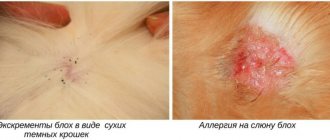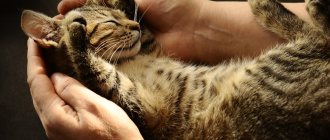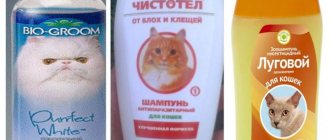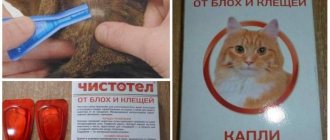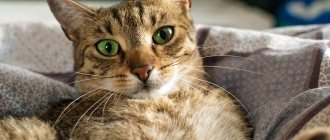The presence of fleas in a cat is not only an unnerving scratching of the pet for the owner, but a possible cause of a serious illness for the animal. Scratching from insect bites can lead to infection of the wounds with pathogenic microflora. In addition, the cat may experience an allergic reaction, accompanied by severe itching, swelling and fever.
Brief information: a flea is a wingless insect that parasitizes warm-blooded animals. The size of the insect is about 3 mm. The flea feeds on the blood of its owner, which it obtains by piercing the skin. It is a carrier of various infections.
Symptoms of infection
Fleas in cats cause characteristic symptoms that are simply impossible not to notice:
- frequent scratching, or more intense than usual licking of the fur;
- restless sleep;
- nervous behavior;
- loss of appetite.
In addition, on the undercoat of the animal you can see traces of insect activity - excrement resembling black grains of sand, and on the skin - scratches, wounds and scabs.
If the disease is not treated, it can lead to the following consequences:
- exhaustion of the animal from lack of sleep and nervous excitement;
- the appearance of bald spots on wool;
- development of anemia (decrease in hemoglobin level). Outwardly, this is manifested by the animal’s lethargy, weight loss, and pale gums. This condition requires treatment by a veterinarian;
- helminth infection;
- allergic dermatitis. This disease is characterized by the appearance of red spots on the skin of the cat's body, against which small blisters then appear. Subsequently, the bubbles burst (on their own or from scratching), and in their place weeping areas form. Over time, they dry out, scar, and scales and crusts form;
- secondary infection of wounds from scratching and, as a result, to inflammation, abscess and even sepsis.
A cat can get fleas even if it does not go outside on its own. Fleas can get on an animal when traveling on public transport, while participating in exhibitions and competitions. After visiting such places, you should examine your cat to prevent the breeding of “uninvited guests.”
Also, a likely source of fleas getting into the apartment and, accordingly, onto the cat is the owner of the animal himself. A flea can jump on a person’s shoes or clothes on the street or in a hallway, and thus get home.
If there are few fleas on a cat, then they may not be visible visually. You can check for the presence of parasites as follows:
- place the animal on a piece of white cloth (fleas, their excrement or eggs will be clearly visible on it);
- Take a special flea comb (with fine teeth) and gently comb the animal's fur from head to tail. Fleas and their metabolic products will either get stuck in the teeth of the comb or fall out onto the bedding fabric;
- You can distinguish dirt from excrement by placing unidentified black particles on a wet cloth. The excrement will change its color from black to brown or red as it contains the animal's blood.
How to check a cat for fleas?
After carefully examining the animal, it is easy to verify the presence or absence of fleas. To do this, you need to use a wide-toothed comb, and, spreading the fur, carefully examine each area of the skin. The presence of cat parasites will be indicated by red spots, irritated skin of the pet, as well as traces of parasite activity - small flesh-colored eggs, dark dirt and pieces of dried blood. If the examination of the pet does not yield results, but its behavior is restless, then you can do it differently: using a slicker brush, comb the animal and place the resulting contents on a sheet of white paper. The detection of small black dots indicates the presence of flea excrement.
Once you have confirmed the presence of blood-sucking parasites, you must immediately begin to fight them, as they serve as carriers of various dangerous infections and can cause allergies in people.
What to do if you find a flea?
First of all, there is no need to panic. Parasitic insects are living organisms, which means they can be destroyed. For this purpose, special flea remedies for cats have been developed, which have been tested and successfully used in practice by millions of cat owners.
A brief algorithm of actions if you find parasites on your pet or in your apartment (house):
- if there are few fleas, or your kitten is still very small, then wash the animal with a special shampoo;
- If there are a large number of fleas, the shampoo may not be effective. In this situation, special drops should be used that will either kill the insects or make their offspring unviable. Read more about how to get rid of fleas from a cat in the next section of this article;
- After antiparasitic treatment, it is necessary to disinfest the room(s) where the cat lives. You can learn how to do this in the last section of this article;
- the next step is to eliminate the damage to the animal’s health caused by fleas. You can relieve your cat from itching and speed up the healing of wounds with the help of Miramistin solution. This pharmaceutical product disinfects wounds and has an anti-inflammatory effect; it can be purchased at a regular pharmacy. If you contact your veterinarian, he will prescribe an antihistamine. A visit to the doctor is also necessary if the wounds begin to rot.
Harm to humans
The damage caused by ectoparasites to people is as follows:
- Bites.
- Transmission of contagious diseases.
Bites
A flea bite is regarded by the body as an irritant:
- A rash appears.
- Scratching appears, fraught with the development of suppuration.
- Dermatitis occurs, which can transform into pyoderma.
- Superficial lymph nodes become hypertrophied.
- Insomnia, migraine, diarrhea, and difficulty breathing develop.
Fleas are stuck
Transmission of contagious diseases
Cat fleas transmit the following infectious diseases to humans:
- Anthrax.
- Tifa.
- Encephalitis.
- Brucellosis.
- Worms.
Flea drops
Parasite drops are the most effective remedy for ridding a cat of fleas. The drops repel or kill insects, destroy pathogenic microflora, and prevent re-infection. Drops are a concentrated solution of various insecticides that are harmful to fleas, but safe for cats.
The principle of action of the drops: the substance, when it gets on the animal’s skin, is absorbed and accumulates in the sebaceous glands. Then, over a long period of time, the substance is gradually released from the glands and repels the parasites, or affects their central nervous system, and they die. The effect on parasites occurs in the intestinal or contact way, i.e. the substance ends up in the stomach of the insect or gets on the surface of the body. After this, an irreversible reaction begins, leading to the death of the cat’s fleas.
Benefits of using drops:
- ease of use. Insect repellents are usually produced in the form of disposable pipettes. It is very convenient for application;
- duration of exposure. The drug should be used once every 2 to 3 months. The frequency of processing is different for each type of drop;
- universality of action. The drops protect the cat not only from fleas, but also from ticks and helminths.
Bonus for the cat owner: there will never be fleas in the room where an animal treated with insecticides lives. Parasites in the room move to the cat's body and then die.
Rules for treating cats for fleas:
- you need to break off the tip on the pipette along a specially made mark;
- then you should spread the fur on the animal’s withers with one hand, and with the other, squeeze a drop from the pipette onto the skin. This action must be repeated in several places in the area from the withers to the shoulder blades.
The amount of product applied depends on the age and weight of the pet. Dosage instructions are included with each type of drop. The drugs are sold without a prescription in veterinary pharmacies, clinics and pet stores.
Experts note that the most popular drops are Bravecto (USA), Stronghold (Zoetis), and Vectra Felice (France).
Important points:
- flea drops for cats can cause individual intolerance in the animal, so if an allergic reaction occurs, the cat should be washed immediately and then contact a veterinary clinic;
- You can treat your cat with flea drops no earlier than 2 days after bathing;
- after applying the drops, the animal cannot be washed for 2 days if the drug is water-based, and for 5 days if it is oil-based;
- on the first day after treatment, when the applied substance is most toxic, you should not pet the cat or allow it near children;
- Before removing fleas from cats, you must carefully read the instructions included with the drops.
Special cases in the treatment of fleas
In general, anti-flea medications are not dangerous for a strong and healthy animal, but if the cat is pregnant, it is extremely important to prevent the medication from getting into the blood or mucous membranes. The consequences of this may be miscarriage or abnormal development of the fetus. In this case, it is recommended to treat the cat with:
Advice! A pregnant cat really needs to get rid of fleas and ticks; if the situation is delayed until the kittens are born, the parasites will immediately be transferred to them, which is very harmful and dangerous.
If a pregnant cat gave birth to kittens before she was cured of parasites, then it is very difficult to choose a harmless treatment. Even collars that will not harm a pregnant cat are very dangerous for newborn kittens. The simplest, but time-consuming method is to wait until the cat begins to leave the kittens, wash it with flea and tick shampoo, and dry it. Then start treating the kittens, as they automatically become infected from their mother.
The presence of fleas and ticks is extremely dangerous for kittens; the parasites feed on their blood, which can lead to the development of anemia for a fragile organism. Fleas are also carriers of infections, such as worms, which harm kittens from the inside. Before you start treating your kitten, you should wait until its eyes open and only then bathe it in flea and tick shampoo. There is no other way that is safe for their health.
Collar
Special repellent collars are saturated with an odor that fleas cannot tolerate, i.e. the product repels (but does not destroy insects). The collar is a porous tape, the material of which retains the smell of the substance applied to it well. This can be either a natural repellent - essential oil, which is safe for cats' health, or a small dose of a synthetic insecticide. For kittens and pregnant cats, collars with natural repellents should be used.
Experts recommend using collars as a preventative measure after the cat’s fleas have already been removed using more powerful insecticidal preparations, or used as a means of complex therapy (i.e. drops + collar). Repellent collars repel not only fleas, but also lice, scabies and ixodid ticks.
The effect of the flea collar lasts up to 8 months. It is very simple to use: just fasten the collar around the cat’s neck and trim off the excess. Do not remove it until the active substance wears off. There is a small “minus”: the fur under the collar cakes, and this is not suitable for cats that take part in exhibitions and competitions.
Collars popular with cat owners: “Bars” (AVZ), “Doctor Zoo”, “Bolfo” (Germany).
If a cat has scratches on its neck, you cannot use a collar; the active substance applied to it can get into the wound and cause a serious allergic reaction in the animal. You can put on a flea collar for cats only after the skin has completely healed.
Appearance
The flea is an insect, dark brown in color, 1...5 mm long. A female that has drunk blood grows up to 1 cm. The arthropod is capable of making long jumps - up to 50 cm in length, has a keen sense of danger, and quickly runs away. On the final segment of the insect's body there is a sensitive organ that detects air movement. The piercing-sucking apparatus allows the flea to make painful bites.
Eggs are white transparent grains measuring <1 mm. The female scatters the embryos everywhere, which increases the chances of survival. Insecticides do not affect flea eggs.
The larvae look like transparent worms with dark spots of swallowed food. They eat any debris of organic origin - flakes of exfoliated skin, excrement of adults, representing semi-digested red blood cells. The larva molts several times until it reaches 4...5 mm. 1…3 weeks after hatching, it spins a cocoon around its body, pupates and freezes. The future flea can stay in this state from one month to two years, maintaining its viability. Insecticides have no effect on the pupa. The cocoon gradually increases in size, and the moment comes when a fully formed adult individual emerges from it, ready for reproduction.
Biology
A cat can feed up to 100 insects. Air humidity of 70% at a temperature of 18...27 ºC is considered optimal for the reproduction of arthropods. Under such conditions, a flea can go from egg to adult in three weeks. If the temperature rises to 37 ºC, the insect's development speed is halved. Under unfavorable conditions, the flea remains viable in the cocoon for 24 months.
The female is ready for intercourse several hours after leaving the cocoon. Mating occurs where different-sex adults meet. In order for the eggs to form, the female needs to drink blood. This can happen within an hour or several months after fertilization.
A single feeding is enough to form 5...15 eggs, which the female shoots from her body, trying to scatter them over long distances. Fleas are individualists. They try not to compete with each other for food. The larvae hatch from the laid eggs two days later. If conditions are far from optimal, the timing of the birth of the cub is extended to two weeks.
Eggs and larvae are not adapted to extreme conditions. In hot, dry weather they dry out, and frost and dampness cause death from hypothermia. The doll is not afraid of climatic surprises.
Shampoo
Shampoo is the mildest remedy in the fight against blood-sucking insects. Special shampoo formulas have been developed that not only make pets' fur clean, but also destroy fleas.
Using shampoo, you can get rid of fleas even in pregnant cats, for whom the use of insecticides contained in flea drops is contraindicated.
Benefits of using shampoo for fleas in cats:
- affordable price;
- ease of use;
- low toxicity;
- Possibility of use for washing cats that are allergic to insecticides.
Shampoo can be dry, which must be used without water, or regular, which must be washed off the animal’s fur. Particular attention should be paid to rinsing the fur; this must be done very carefully, because cats, no matter how well they are wiped, will still lick themselves.
When choosing a detergent, you should pay attention to what breeds of cats the flea shampoo is intended for: long-haired, short-haired or hairless. It should also be clarified at what age this remedy can be used. The fact is that shampoo for small kittens and pregnant cats contains a minimal amount of toxic ingredients, and in the product for washing adult animals their concentration is much higher.
Experts recommend the following types of shampoos: “BIO-GROOM” (USA), “Bars” (AVZ), “Fitoelita” (Veda).
Flea shampoos for cats consist of three main ingredients:
- components that create soap foam;
- substances that care for the animal's fur. These are decoctions of medicinal herbs, essential oils;
- insecticides. Both synthetic substances (phenothrin, decamethrin) and natural ones (penitrin contained in Caucasian and Persian chamomile) are used.
Folk remedies
Of course, as in treating people, among the owners of beautiful purring creatures there are connoisseurs of traditional medicine. This may not always benefit the cat, but it is worth trying this option to get rid of nits.
There are quite a lot of means and substances for the folk method of removing unexpected guests from wool; it is important to correctly combine the components:
- Lavender with eucalyptus has a good effect on the cat and helps to expel unwanted insects from the fur of your beloved pet;
- Wormwood is an excellent remedy for treating a cat against fleas;
- Rosemary tincture helps perfectly in the process of removing parasites from wool;
- Garlic can be an effective remedy for pests in the fur and skin of animals, but it is important to prepare it correctly, a small amount of garlic is diluted with a liter of water and infused, then a little applied to the pet’s withers.
It is possible to treat an animal with folk remedies only under special circumstances when other options are contraindicated. Also, such methods are best used by those people who understand this type of treatment, so as not to harm their pet.
How to remove fleas from a cat at home?
You can remove fleas from a cat at home yourself, or by visiting a veterinary clinic. At the clinic, the doctor will examine the animal, determine the severity of the lesion, evaluate the individual clinical situation and select the appropriate method for removing insects.
Diagnosing the presence of fleas is not difficult for an ordinary person who is far from veterinary medicine. Therefore, the sooner treatment begins, the more effective it will be. Parasites are very prolific, so postponing treatment “for later” is unacceptable.
The danger of fleas for pets
In addition to the obvious inconveniences that fleas bring to an animal, there are a number of additional dangers:
- When bitten, the integrity of the skin is compromised and infection can enter the wounds;
- substances that a flea injects into the animal’s blood during a bite can cause an allergic reaction.
- fleas carry fungal and viral infections and can infect an animal with helminths;
- constant frequent bites cause anemia;
- the itching caused by bites affects the mental state of the animal - it becomes nervous and hysterical.
Flea infestation is especially dangerous for small kittens. Blood-sucking insects cause anemia in them, leading to complete exhaustion and death. It is important to detect a disease in a kitten in time in order to help it. To do this, you should examine not only the animal, but also its sleeping place. To understand where a domestic cat gets fleas , it’s a good idea to look under the carpeting, behind sofas and other upholstered furniture. Fleas are dangerous because they are excellent at hiding and waiting for the right moment to attack.
Are cat fleas dangerous for humans?
Cat fleas do not live on people, but they can bite them and thereby transmit the causative agents of some serious diseases.
Among the most dangerous diseases that cause fleas in domestic cats are:
- hepatitis - inflammatory damage to the liver;
- brucellosis – damage to many body systems: cardiovascular, respiratory, digestive, musculoskeletal, nervous, etc.;
- encephalitis - inflammation of the brain substance;
- helminths – worms that parasitize the body of animals and humans;
- Plague is a fatal disease (without treatment it ends in death). It is extremely rare in Russia; the last case was recorded in 2020 in Altai. Those cat owners who export their pets to Central Asia, Africa, and America should be concerned. It is especially important for them to know how to get rid of fleas from a cat as quickly and efficiently as possible.
The most common consequences of a flea bite for humans are allergic reactions, manifested in the form of severe itching and redness. It is also possible for infection to occur in scratched bite areas. This can already lead to a more serious outcome - purulent inflammation of the skin and penetration of infection into the bloodstream. This development of events is fraught with many dangerous diseases, including sepsis (blood poisoning).
Therefore, flea control is necessary not only to protect the cat from parasitic insects, but also to preserve human health.
Home disinfection
After treating a cat, an important step in the fight against fleas is treating the home.
Professional disinfection
Professional disinfection is the most effective. A team of specialists will arrive at your home, assess the sanitary condition of the home and choose the most appropriate disinfection method. Typically, disinfection is carried out either using a heat gun or using chemicals. The owner is only required to prepare the house and pay for the services.
Important! A few days after professional treatment, you may find fleas on the floor. However, do not think that the service was provided poorly. Insects could easily remain in the cracks and gaps, but upon contact with the treated surface they quickly die. A similar phenomenon can be observed within 5 weeks after the visit of specialists.
Disinfect yourself
You can disinfect your home yourself using a spray or powder.
Processing stages:
- Remove children, animals and indoor plants from the house.
- To throw out the trash.
- Move furniture away from the walls. Remove from the walls all objects that hang on them.
- Put on work clothes.
- Spray the entire home, including carpets, upholstered furniture, clothing, shoes and bedding. Particular attention should be paid to the animal's belongings.
- Close doors and windows. Leave the house for several hours, ideally all night.
- Upon return, ventilate the rooms well, wash all surfaces and wash all items that have been processed.
Unlike sprays, powders are less effective, but when using them you do not need to leave your home. It is enough to scatter the granules in places where fleas are most concentrated (cracks, areas behind the baseboard). Upon contact with the granular substance, not only adult individuals die, but also their larvae and eggs.
Room treatment
Without treating all rooms in the house, treating a cat may be ineffective - at best, it will take several weeks, at worst, several months. Therefore, the animal and the entire room should be treated simultaneously.
Special means
The easiest way is to purchase sprays that kill insects. The label must indicate that the product is also suitable for getting rid of fleas - not all aerosols are designed for these insects.
The treatment is carried out quickly so as not to inhale the toxic substance. The nose and mouth should be covered with a scarf or scarf.
The product is kept for from half an hour to 3 hours (the exact time is indicated on the label), and then the room is thoroughly ventilated for at least an hour. If possible, it is better to treat all the rooms at once, and at this time, together with the animals, be in another place. If this is not possible, then the rooms are processed in turn, but on the same day.
Some products require rinsing off—usually insecticides designed to be sprayed exclusively on floors and baseboards.
Traditional methods
To eliminate and prevent the appearance of fleas, aromatic herbs or dead wood are often used. These are geranium, mint, wormwood, sage, tansy, lavender. Plants are placed in floor pots, and dead wood is placed in small quantities behind baseboards and ventilation grilles.
It is recommended to wash floors by adding 5-10 drops of essential oils to the water. Many of them repel insects and fill the air with a pleasant aroma and freshness.
Call exterminators
Exterminators are called in in severe cases:
- there are fleas not in one apartment, but in several, and large-scale treatment is required;
- fleas live in the basements of apartment buildings;
- fleas have settled in the basement of a private house.
In these cases, a team of specialists treats all premises with very strong agents. Usually after the procedure you can return home only on the second or third day, and before that you need to ventilate your home for 10-12 hours.
Reviews
Oleg: The question of what to do if a cat has fleas became relevant for us this summer. I tried different folk remedies, but I can’t get rid of these parasites. You will have to use chemicals, no matter how much you would like to protect your pet from harmful substances.
Irina: Our cat became infected with fleas in the summer at the dacha, from the neighbor’s pets. Before returning to the apartment, they were taken out with Bars drops. They helped us quite quickly, but for prevention they also put on a flea collar.
Natalya: Our cat suddenly developed fleas. We took them out for a long time and realized that it is important not only how and with what to treat the cat against fleas, but also to do wet cleaning in the apartment. After all, these creatures multiply very quickly and infect the entire room. What to wash with? I use salt or white for this purpose. Cheap and effective, as practice has shown.
Elena: Having discovered fleas on the cat, I bathed him in a decoction of tansy and wormwood herbs, and put a flea collar on him. For the purpose of prevention, I repeat such water procedures every 2 weeks. You can also use laundry soap.
